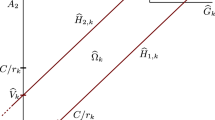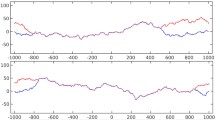Abstract
We study the directed last-passage percolation model on the planar integer lattice with nearest-neighbor steps and general i.i.d. weights on the vertices, outside the class of exactly solvable models. In Georgiou et al. (Probab Theory Relat Fields, 2016, doi:10.1007/s00440-016-0729-x) we constructed stationary cocycles and Busemann functions for this model. Using these objects, we prove new results on the competition interface, on existence, uniqueness, and coalescence of directional semi-infinite geodesics, and on nonexistence of doubly infinite geodesics.

Similar content being viewed by others
References
Alm, S.E.: A note on a problem by Welsh in first-passage percolation. Combin. Probab. Comput. 7(1), 11–15 (1998)
Alm, S.E., Wierman, J.C.: Inequalities for means of restricted first-passage times in percolation theory. Combin. Probab. Comput. 8(4), 307–315 (1999). Random graphs and combinatorial structures (Oberwolfach, 1997)
Auffinger, A., Damron, M.: Differentiability at the edge of the percolation cone and related results in first-passage percolation. Probab. Theory Related Fields 156(1–2), 193–227 (2013)
Auffinger, A., Damron, M., Hanson, J.: Limiting geodesics for first-passage percolation on subsets of \(\mathbb{Z}^2\). Ann. Appl. Probab. 25(1), 373–405 (2015)
Bakhtin, Y.: Burgers equation with random boundary conditions. Proc. Am. Math. Soc. 135(7), 2257–2262 (2007) (electronic)
Bakhtin, Y.: The Burgers equation with Poisson random forcing. Ann. Probab. 41(4), 2961–2989 (2013)
Bakhtin, Y.: Inviscid burgers equation with random kick forcing in noncompact setting. Electron. J. Probab. 21, 1–50, paper no. 37 (2016). doi:10.1214/16-EJP4413
Bakhtin, Y., Cator, E., Khanin, K.: Space-time stationary solutions for the Burgers equation. J. Am. Math. Soc. 27(1), 193–238 (2014)
Bakhtin, Y., Khanin, K.: Localization and Perron-Frobenius theory for directed polymers. Mosc. Math. J. 10(4), 667–686, 838 (2010)
Cator, E., Pimentel, L.P.R.: A shape theorem and semi-infinite geodesics for the Hammersley model with random weights. ALEA Lat. Am. J Probab. Math. Stat. 8, 163–175 (2011)
Cator, E., Pimentel, L.P.R.: Busemann functions and equilibrium measures in last passage percolation models. Probab. Theory Related Fields 154(1–2), 89–125 (2012)
Cator, E., Pimentel, L.P.R.: Busemann functions and the speed of a second class particle in the rarefaction fan. Ann. Probab. 41(4), 2401–2425 (2013)
Cohn, H., Elkies, N., Propp, J.: Local statistics for random domino tilings of the Aztec diamond. Duke Math. J. 85(1), 117–166 (1996)
Coupier, D.: Multiple geodesics with the same direction. Electron. Commun. Probab. 16, 517–527 (2011)
Damron, M., Hanson, J.: Busemann functions and infinite geodesics in two-dimensional first-passage percolation. Commun. Math. Phys. 325(3), 917–963 (2014)
Durrett, R., Liggett, T.M.: The shape of the limit set in Richardson’s growth model. Ann. Probab. 9(2), 186–193 (1981)
W, E., Khanin, K., Mazel, A., Sinai, Y.: Invariant measures for Burgers equation with stochastic forcing. Ann. Math. (2) 151(3), 877–960 (2000)
Ferrari, P.A., Kipnis, C.: Second class particles in the rarefaction fan. Ann. Inst. H. Poincaré Probab. Statist. 31(1), 143–154 (1995)
Ferrari, P.A., Martin, J.B., Pimentel, L.P.R.: A phase transition for competition interfaces. Ann. Appl. Probab. 19(1), 281–317 (2009)
Ferrari, P.A., Pimentel, L.P.R.: Competition interfaces and second class particles. Ann. Probab. 33(4), 1235–1254 (2005)
Garet, O., Marchand, R.: Coexistence in two-type first-passage percolation models. Ann. Appl. Probab. 15(1A), 298–330 (2005)
Georgiou, N., Rassoul-Agha, F., Seppäläinen, T.: Geodesics and the competition interface for the corner growth model (2015). arXiv:1510.00860v1 (preprint)
Georgiou, N., Rassoul-Agha, F., Seppäläinen, T.: Stationary cocycles and Busemann functions for the corner growth model. Probab. Theory Relat. Fields (2016). doi:10.1007/s00440-016-0729-x
Georgiou, N., Rassoul-Agha, F., Seppäläinen, T., Yılmaz, A.: Ratios of partition functions for the log-gamma polymer. Ann. Probab. 43(5), 2282–2331 (2015)
Hoang, V.H., Khanin, K.: Random Burgers equation and Lagrangian systems in non-compact domains. Nonlinearity 16(3), 819–842 (2003)
Hoffman, C.: Coexistence for Richardson type competing spatial growth models. Ann. Appl. Probab. 15(1B), 739–747 (2005)
Hoffman, C.: Geodesics in first passage percolation. Ann. Appl. Probab. 18(5), 1944–1969 (2008)
Howard, C.D., Newman, C.M.: Geodesics and spanning trees for Euclidean first-passage percolation. Ann. Probab. 29(2), 577–623 (2001)
Iturriaga, R., Khanin, K.: Burgers turbulence and random Lagrangian systems. Commun. Math. Phys. 232(3), 377–428 (2003)
Jockusch, W., Propp, J., Shor, P.: Random domino tilings and the arctic circle theorem (1998). arXiv:math/9801068
Licea, C., Newman, C.M.: Geodesics in two-dimensional first-passage percolation. Ann. Probab. 24(1), 399–410 (1996)
Mairesse, J., Prabhakar, B.: The existence of fixed points for the \(\cdot /GI/1\) queue. Ann. Probab. 31(4), 2216–2236 (2003)
Marchand, R.: Strict inequalities for the time constant in first passage percolation. Ann. Appl. Probab. 12(3), 1001–1038 (2002)
Martin, J.B.: Limiting shape for directed percolation models. Ann. Probab. 32(4), 2908–2937 (2004)
Mountford, T., Guiol, H.: The motion of a second class particle for the TASEP starting from a decreasing shock profile. Ann. Appl. Probab. 15(2), 1227–1259 (2005)
Newman, C.M.: A surface view of first-passage percolation. In: Proceedings of the International Congress of Mathematicians, vols. 1, 2 (Zürich, 1994), pp. 1017–1023. Birkhäuser, Basel (1995)
Pimentel, L.P.R.: Multitype shape theorems for first passage percolation models. Adv. Appl. Probab. 39(1), 53–76 (2007)
Pimentel, L.P.R.: Duality between coalescence times and exit points in last-passage percolation models. Ann. Probab. (2015). arXiv:1307.7769 (to appear)
Prabhakar, B.: The attractiveness of the fixed points of a \(\cdot /GI/1\) queue. Ann. Probab. 31(4), 2237–2269 (2003)
Rassoul-Agha, F., Seppäläinen, T., Yılmaz, A.: Quenched free energy and large deviations for random walks in random potentials. Commun. Pure Appl. Math. 66(2), 202–244 (2013)
Rost, H.: Nonequilibrium behaviour of a many particle process: density profile and local equilibria. Z. Wahrsch. Verw. Gebiete 58(1), 41–53 (1981)
Seppäläinen, T.: Hydrodynamic scaling, convex duality and asymptotic shapes of growth models. Markov Process. Related Fields 4(1), 1–26 (1998)
Seppäläinen, T.: Existence of hydrodynamics for the totally asymmetric simple \(K\)-exclusion process. Ann. Probab. 27(1), 361–415 (1999)
Wehr, J.: On the number of infinite geodesics and ground states in disordered systems. J. Stat. Phys. 87(1–2), 439–447 (1997)
Wehr, J., Woo, J.: Absence of geodesics in first-passage percolation on a half-plane. Ann. Probab. 26(1), 358–367 (1998)
Wüthrich, M.V.: Asymptotic behaviour of semi-infinite geodesics for maximal increasing subsequences in the plane. In: In and out of equilibrium (Mambucaba, 2000), Progr. Probab., vol. 51, pp. 205–226. Birkhäuser Boston, Boston (2002)
Acknowledgments
N. Georgiou was partially supported by a Wylie postdoctoral fellowship at the University of Utah and the Strategic Development Fund (SDF) at the University of Sussex. F. Rassoul-Agha and N. Georgiou were partially supported by National Science Foundation Grant DMS-0747758. F. Rassoul-Agha was partially supported by National Science Foundation Grant DMS-1407574 and by Simons Foundation Grant 306576. T. Seppäläinen was partially supported by National Science Foundation Grants DMS-1306777 and DMS-1602486, by Simons Foundation Grant 338287, and by the Wisconsin Alumni Research Foundation.
Author information
Authors and Affiliations
Corresponding author
A Auxiliary technical results
A Auxiliary technical results
Cocycles satisfy a uniform ergodic theorem. The following is a special case of Theorem 9.3 of [24]. Note that a one-sided bound suffices for a hypothesis. Recall Definition 3.1 of stationary \(L^1(\mathbb {P})\) cocycles. Let \(h({B})\in \mathbb {R}^2\) denote the vector that satisfies
Theorem A.1
Assume \(\mathbb {P}\) is ergodic under the group \(\{T_x\}_{x\in \mathbb {Z}^2}\). Let B be a stationary \(L^1(\mathbb {P})\) cocycle. Assume there exists a function V such that for \(\mathbb {P}\)-a.e. \(\omega \)
and \(\max _{i\in \{1,2\}} B(\omega ,0,e_i)\le V(\omega )\). Then
If the process \(\{V(T_x\omega ):x\in \mathbb {Z}^2\}\) is i.i.d., then a sufficient condition for (A.1) is \(\mathbb {E}(\vert V\vert ^p)<\infty \) for some \(p>2\) [40, Lemma A.4].
The following is a deterministic fact about gradients of passage times. This idea has been used profitably in planar percolation, and goes back at least to [1, 2]. See Lemma 6.3 of [23] for a proof.
Lemma A.2
Fix \(\omega \in \varOmega \). Let \(u,v\in \mathbb {Z}^2_+\) be such that \(\vert u\vert _1=\vert v\vert _1\ge 1\) and \(u\cdot e_1\le v\cdot e_1\). Then
Rights and permissions
About this article
Cite this article
Georgiou, N., Rassoul-Agha, F. & Seppäläinen, T. Geodesics and the competition interface for the corner growth model. Probab. Theory Relat. Fields 169, 223–255 (2017). https://doi.org/10.1007/s00440-016-0734-0
Received:
Revised:
Published:
Issue Date:
DOI: https://doi.org/10.1007/s00440-016-0734-0
Keywords
- Busemann function
- Coalescence
- Cocycle
- Competition interface
- Directed percolation
- Geodesic
- Last-passage percolation




